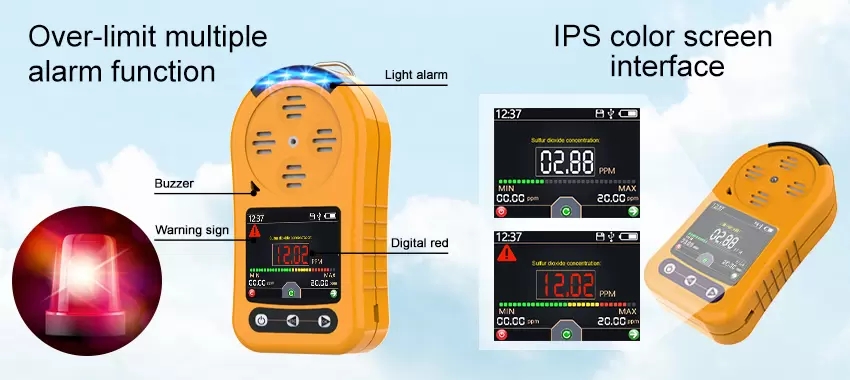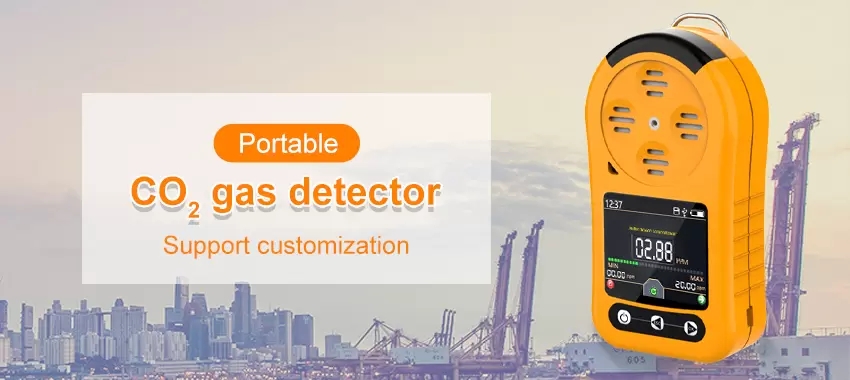Background:
CO2 (carbon dioxide) concentration is a key indicator of indoor air quality. Good air quality can make people in it feel better and more productive. Excessive CO2 concentrations, on the other hand, represent poor indoor air quality, often due to insufficient air conditioning and air recirculation. This condition can lead to well-documented health problems such as Sick Building Syndrome (SBS). Other indoor toxins such as fine dust, mold, pollen, bacteria and even asbestos can also have health effects. We can use gas sensors for online monitoring of carbon dioxide concentration.
CO2 limits prevent disease:
Over the years, due to human activities, the concentration of greenhouse gases and the amount of CO2 in the environment has gradually increased. Today's ambient values are slightly above 400 ppm (0.04%), which represents healthy fresh air. Indoors, CO2 concentrations up to 1000 ppm (0.1%) are still considered acceptable. This can be achieved with a good supply of fresh air. From a scientific point of view, CO2 concentration values are critical to health. Because higher CO2 concentrations can have long-term negative effects on the human body.
Even with CO2 concentrations in the range of 1000 ppm (0.1%) to 2000 ppm (0.2%), poor air quality is evident. People feel tired in such an environment. If CO2 levels continue to rise, people experience stuffy heat, headaches, drowsiness, decreased concentration, and increased heart rate. Therefore, the World Health Organization recommends that the indoor CO2 concentration be controlled within 1000 ppm (0.1%) as much as possible. The U.S. Environmental Protection Agency (EPA) explicitly recommends improving indoor air quality through outdoor air circulation. A heating, ventilation and air conditioning system (HVAC) can be used, which integrates heating, ventilation, and air conditioning.
CO2 sensors are essential in many applications:
Considering the needs of a large number of applications, it is not surprising that market analysts expect the annual growth rate of the CO2 sensor market to reach double digits. According to the "Gas and Particulate Matter Sensors - 2018 Edition" report released, the gas sensor market size will reach $1 billion by 2022. CO2 sensors can be used to monitor indoor air. To ensure better ventilation in homes, schools, offices and commercial buildings. Thereby improving people's attention and productivity. Smaller size sensors are also suitable for living areas and corresponding Internet of Things (IoT) devices. Such as digital assistants, smoke detectors, routers, air purifiers, and air conditioning systems, etc., and can even be installed in laptops or monitors.

Application of carbon dioxide sensor:
In fact, there are many other applications of CO2 sensors. For example, vehicle CO2 monitoring can adjust the driving position or the air quality in the whole vehicle. In agriculture, CO2 sensors can be used to control CO2 concentrations in greenhouses for higher yields and cost savings. CO2 sensors can also be used in medical applications such as CO2 detectors (capnometry). The CO2 detector is a real-time method for measuring the CO2 content of a patient's exhaled breath, which is particularly effective in the field of anesthesia.
Industrial cases include detecting CO2 leaks near CO2 gas sources such as dry ice reservoirs, oil storage tanks, and underground gas sources. Smart cities can also link CO2 emission sources to vehicle density for traffic management.
CO2 sensor technology today:
Currently, non-diffusion infrared (NDIR) sensors are widely used. Especially in the field of intelligent buildings, it is widely used. However, NDIR sensors are relatively large in size and expensive. Therefore it can only be used in limited areas. This sensor consists of an infrared light source, a sampling chamber, a filter, and a reference and absorption infrared detector. Provides true and accurate CO2 measurement. However, except for purely aesthetic reasons, NDIR sensors are not suitable for installation in mobile devices, thermostats, and other smart home components in daily life. The main reasons are higher cost and lower integration capability due to its form factor.
There is currently no comparable solution on the market - both true and accurate CO2 measurement and cost-effective. Although so-called eCO2 sensors can be used to detect various types of indoor pollutants, they are not a good substitute for NDIR sensors. The eCO2 sensor does not perform the actual measurement, it uses an algorithm to calculate the equivalent CO2 value. Its calculation assumes that the CO2 in the area is mainly generated by the people present. Therefore, eCO2 only provides estimates based on many assumptions. And the adjustment of indoor air quality based on this eCO2 value is only done based on information that may be inaccurate.
MEMS gas sensor:
Gas molecules absorb only certain wavelengths of light, and CO2 typically only absorbs light at a wavelength of 4.2 µm. An infrared light source with a filter provides energy to the gas in rapid succession in pulses of light of precise wavelengths. This results in rapid heating and cooling of the gas sample, which in turn results in thermal expansion and contraction. The resulting sound can be recorded and evaluated using a microphone, and used to calculate the CO2 content in the gas. The higher the CO2 concentration, the stronger the acoustic signal. The use of highly sensitive MEMS microphones as detectors enables significant miniaturization compared to NDIR-CO2 sensors. MEMS sensors have begun to enter the field of people's lives.

Advantages of CO2 Sensor Solutions:
The explosion-proof carbon dioxide gas alarm of Jingxun is specially developed and produced for the harsh environment. The core detection device is the professional detection of carbon dioxide concentration sensor probe. It has the characteristics of wide measurement range, high precision, good linearity, good versatility, convenient use, convenient installation, long transmission distance and moderate price. Industrial-grade sensor for continuous monitoring of gas concentrations. The certificate is complete and there are many options. Available on demand. The alarm controller has a variety of options, and the optional external control ports are abundant.
Gas Analyzer SO2 CO2 NOx microcomputer multi:
Gas analyzer is a gas sensor independently developed by Jingxun Unimpeded using different detection principles for multi-gas detection. The gas detector adopts microcomputer analysis, which can detect the concentration of NOx, SO2, CO2, CO, O3 and O2. Gas analyzer is suitable for gas detection in thermal power plant, steel plant, non-ferrous metal smelter, aluminum smelter, cement plant, phosphate fertilizer plant, nitric acid plant, sulfuric acid plant, petrochemical, chemical fiber, industrial furnace, boiler, civil heating boiler and other occasions.
 : +86 155 8830 2704
: +86 155 8830 2704 : jxdziot@gmail.com
: jxdziot@gmail.com
